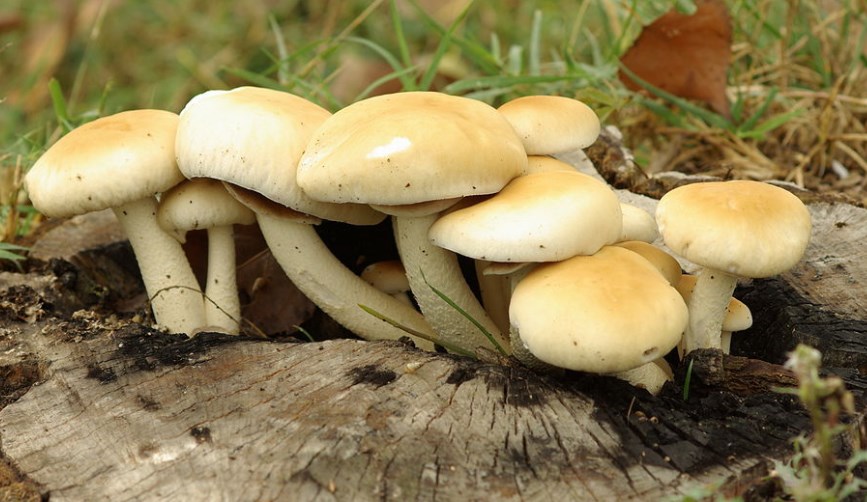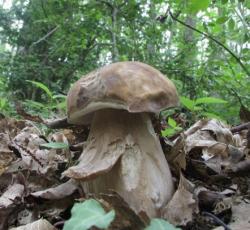Agrocybe aegerita or Chestnut mushroom is an excellent edible mushroom that can be used both for wet dishes and for drying and storing in oil. The Agrocybe aegerita has been known since ancient times and was probably the first fungus to be cultivated.
Indice
Other names of Agrocybe aegerita
The Agrocybe aegerita is commonly called chestnut mushroom. Some synonyms are: Agrocybe cylindracea, Pholiota aegirita, Agaricus brigantii, Dryophila aegirita. It is also called Pioppino mushroom but should not be confused with the Armillaria mella.
Description of the Chestnut mushroom
Cap
The cap of the chestnut mushroom measures from 4 to 12 cm in diameter up to a maximum of 15 cm. At the beginning of its development, the cap of the poplar is hemispheric, then becomes convex or flattened.
The shape is irregular, especially in the young specimens and the margin of the hair almost always remains downward. It happens that the cap flattens if it is compressed by some branch or by the trunk of a tree. The cap is slightly slimy when wet and sometimes cracks or fades on the edge.
Gills
The gills of the fungus Agrocybe aegerita are thin and very thick. Several of them have a creamy white colour which then becomes greyish and brownish with the maturity of the fungus.
Stipe
The stipe of the Agrocybe aegerita mushroom measures in height from 5 to 10 cm with a maximum recognized of 15 cm. The thickness is 1, maximum 1.5 cm and the shape is cylindrical. The stipe is quite delicate; in fact it breaks easily even if it is full. Often we find it curved. The colour of the stipe is white with some yellow shades and brown spots.
Ring
In the upper part of the stipe there is also a fixed and persistent ring, of white and then brown colour and of thick and robust appearance.
Flesh
The flesh of Agrocybe aegerita is white in the cap and brownish in the stipe. In the stem the flesh is hard and in the cap it is thick and firm but never fibrous. The good smell and taste is vaguely hazelnut.

Habitat of Chest Mushroom
Agrocybe aegerita is a fungus that can live both as a parasite and as a saprophyte fungus. Usually it develops, just as the name says, on the trunks of the poplars. More rarely we find it on figs, apricots and willows. It is also found on mulberries, olive trees, oaks or horse chestnuts.
It is a mushroom that is very common in Europe, especially in hot countries and especially in the plains. It is not frequently found in central and northern Europe.
Usually, the Agrocybe aegerita grows inside the deep wounds of the host plants. Crepe on dead wood, leaves and trunks of broadleaf trees. It also grows on live trees (in this case it grows right across the trunk from the ground to a fair height) or on injured or damaged trees. For this reason, to collect it often requires the use of a knife the mushroom.
The environments where you can collect the
Agrocybe aegerita most frequently are the city parks and tree-lined streets that have on the edge of the poplars.
Period of Growth of Agrocybe Aegerita
Agrocybe aegerita begins to grow from the mycelium between February and March and continues until November. In practice you can find poplars from spring until late autumn. The growth will be more abundant in rainy periods.
Once a chestnut mushroom collection point has been located, it can easily be found in the same place almost every month, taking into account the lunar phase in which the fungus was first collected.
The Agrocybe aegerita develops in groups that are often very numerous. It does not make much distinction between altitude as it is located from the plain to the mountain.
Cultivation of the Agrocybe aegerita
The chestnut mushroom, as previously mentioned, is a mushroom that lends itself well to cultivation just like the mushroom pleurotus ostreatus, the cultivation of which has been studied in depth on our website. We have talked specifically also about the bales of mushrooms. The procedure for the cultivation of the poplar is explained below:
Once a poplar plant has been identified, it is cut down. The stem is stored in a shady area without wind and is cut, at the beginning of spring, into small strains of 25 cm each.
These strains are inoculated with spores or mycelium and stratified in holes together with the mycelium. The pit is then covered with boards and a sheet of polyethylene and about 20 cm of soil. Between the last layer of wood and the surface there must be 20-30 cm of vacuum.
Now they wait three months and bury the logs in a vertical position so that they emerge slightly from the ground. It is at this time that the mycelium fructifies and numerous carpophore bodies appear between the ground and the trunks.
Recipes with Chestnut mushroom
Agrocybe Aegerita mushroom has an excellent intense perfume and a fungal taste that is always appreciated is delicious. Its flesh is firm and the color is white and clean.
Usually in the kitchen stipes are discarded because, as often happens with other mushrooms, they are too woody and fibrous. Clean the gills well under running water so as to eliminate the spores and cut the mushroom cap finely before preparation.
Chestnut mushrooms Trifolati
One of the tastiest ways to prepare it is to make it trifolate in butter and extra virgin olive oil, over a very lively heat.
IDENTITY CARD
CAT COLOR: brownish
STIPE HEIGHT: 4-15 cm
STIPE COLOR: white
GILLS: whitish
FLESH: White
SMELL: of flour
TASTE: delicate
SPORES: brunettes
HABITAT: Hardwoods
Did you find what you were looking for? See also here:
- Ganoderma Lucidum
- Armillaria Mellea
- Amanita Caesarea
- Agaricus Bisporus
- Amanita Phalloides
- Coriolus Versicolor
- Flammulin Velutipes
- Marasmius Oreades
- Pleurotus Ostreatus
- Agaricus Campestris
- Macrolepiota procera
